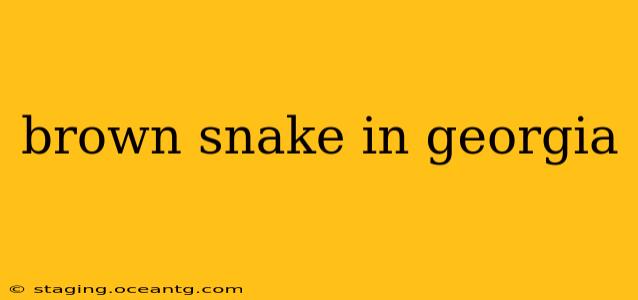Georgia is home to a variety of snakes, and several species exhibit brown coloration. Identifying a brown snake accurately is crucial for safety and understanding the local ecosystem. This guide will help you distinguish between common brown snakes found in Georgia, their habitats, and how to best react if you encounter one.
What Kind of Brown Snakes Live in Georgia?
Several snakes in Georgia display brown hues, making identification crucial. The most common brown snakes encountered include:
- Copperheads: These venomous pit vipers are often confused with other brown snakes. They have a distinctive hourglass-shaped marking on their back, a copper-colored head, and a heat-sensing pit between their eye and nostril.
- Eastern Hog-nosed Snakes: These are non-venomous and known for their dramatic defense mechanisms, including playing dead. They are typically brown with darker blotches, and their upturned snout is a key identifying feature.
- Brown Snakes (Storeria dekayi): This small, harmless species is uniformly brown or grayish-brown, lacking distinct markings.
- Rat Snakes (various species): While many rat snakes exhibit gray or black coloration, some subspecies can appear brown, often with darker stripes or blotches. They are non-venomous.
- Corn Snakes: While often brightly colored in captivity, wild corn snakes can be predominantly brown, sometimes with reddish hues. They're non-venomous.
It's important to note that this isn't an exhaustive list, and variations in color can occur within species. Precise identification often requires close observation and, in cases of uncertainty, consulting a herpetologist or wildlife expert.
Where Do Brown Snakes in Georgia Live?
The habitats of brown snakes in Georgia vary widely depending on the species:
- Copperheads: Prefer rocky areas, wooded hillsides, and areas with dense underbrush. They're often found near water sources.
- Eastern Hog-nosed Snakes: Favor sandy or loose soil areas, often found in fields, meadows, and near the edges of forests.
- Brown Snakes (Storeria dekayi): These shy snakes inhabit moist environments, such as under leaf litter, logs, and rocks.
- Rat Snakes: Are highly adaptable and can be found in a variety of habitats, including forests, fields, and even urban areas.
- Corn Snakes: Favor grasslands, fields, and areas with rocky outcrops.
Are Brown Snakes in Georgia Dangerous?
The danger posed by a brown snake in Georgia depends entirely on the species:
- Copperheads: Are venomous and their bite requires immediate medical attention. Their venom can cause significant pain, swelling, and other systemic effects.
- Eastern Hog-nosed Snakes: Are completely harmless despite their intimidating display.
- Brown Snakes (Storeria dekayi): Are entirely non-venomous and pose no threat to humans.
- Rat Snakes: Are non-venomous constrictors; they might bite in self-defense, but their bite is not medically significant.
- Corn Snakes: Are also non-venomous and pose no threat to humans.
How to Identify a Brown Snake in Georgia (Beyond Color)
Color alone is insufficient for accurate identification. Pay attention to these additional features:
- Head Shape: Copperheads have a triangular-shaped head, while hog-nosed snakes have an upturned snout.
- Body Pattern: Look for distinct markings like the hourglass pattern of copperheads or stripes/blotches on rat snakes.
- Size and Build: Brown snakes (Storeria dekayi) are small and slender, while rat snakes are larger and more robust.
- Behavior: Observe the snake's behavior. Hog-nosed snakes' defensive posturing is quite distinctive.
What Should I Do If I See a Brown Snake?
- Maintain a safe distance: Do not approach or try to handle the snake.
- Identify the snake (if possible): Observe its features carefully, but from a safe distance. Take a picture if you can.
- Seek professional help if bitten by a venomous snake: Call emergency services immediately.
- Contact wildlife authorities if you have concerns: They can offer advice or safely remove the snake if necessary.
Remember, responsible coexistence with wildlife involves respecting their space and understanding their role in the ecosystem. By learning to identify and understand the snakes in your area, you can ensure your safety and appreciate the diversity of Georgia's natural environment.
